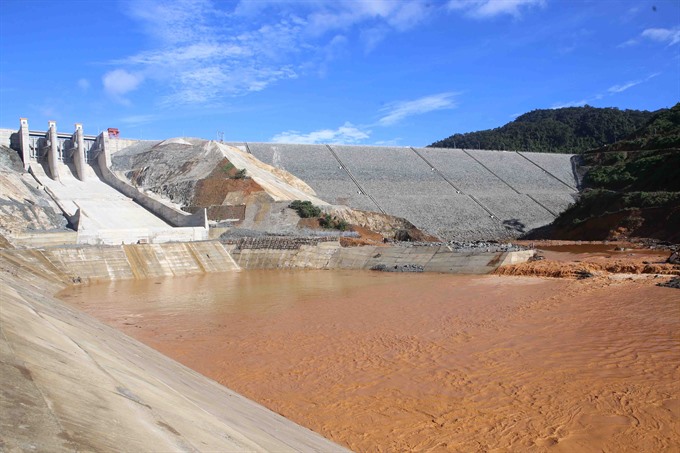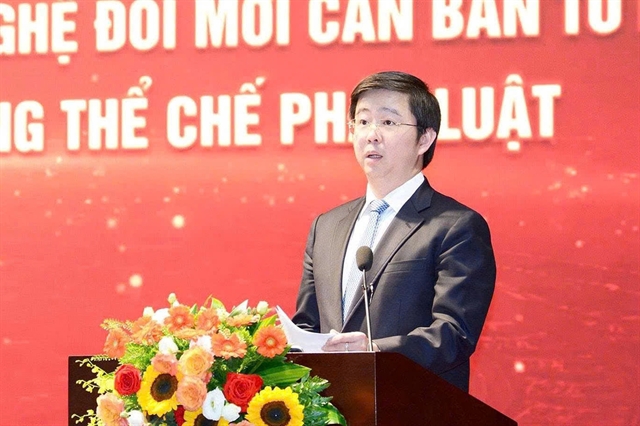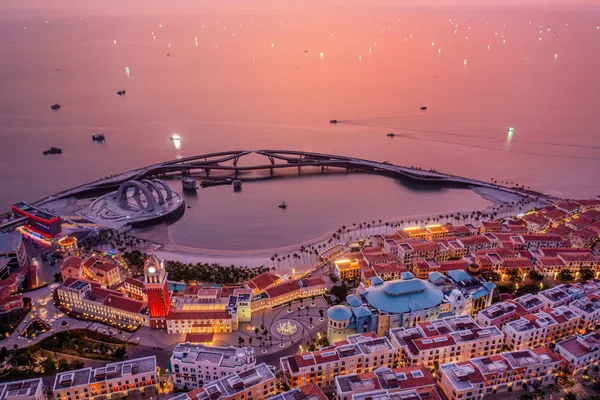.jpg) Society
Society

The mass development of hydropower power plants in the country's central regions over the past 10 years has led to a series of problems in the central regions, such as flooding, riverbank erosion, drought and degradation of water quality.
 |
| The Sông Bung 2 Hydropower Plant in Nam Giang District in the central Quảng Nam Province. — VNA/VNS Photo Trần Lê Lâm |
A river too silted up for boats to sail through. A field choked by sand intrusion. These are two of the photos that Nguyễn Khánh Tâm Anh brought to a conference held this week on hydropower plant development to illustrate the heavy toll that his family and many others have been suffering due to the mass development of hydropower plants in the country’s central regions over the past 10 years.
The conference, organised by the Centre of Social Research and Development, was designed to provide a platform for discussion among authorities, hydropower plants, experts and residents on sustainable development of hydropower plants.
Holding up a photo, the resident of Đại Lộc District in the central province of Quảng Nam told participants that in the dry season, "rivers are parched because hydropower plants do not discharge water. Đại Lộc co-operative used to have 120 boats to transporting freight to Nam Giang District, but has had to stop operation.”
According to Anh, 40 households in Đại Hồng Commune that used to rely on the boats for their living, have either become jobless or work as seasonal labourers to get by.
Anh also brought up the September incident at Sông Bung 2 Hydropower Plant in Nam Giang District, where a tunnel broke releasing about 28 million cubic metres of water that swept away village homes downstream. “We were so terrified that we had to flee to the forest to escape the water. It was terrible,” Anh said.
Further down to the south, about 1,000 households of coffee and pepper farmers in Krông Ana District in the Central Highlands province of Đắk Lắk also suffer from water shortage due to the Buôn Kuôp hydropower plant in Sêrêpôk River.
“Every year, Sêrêpôk River provided us with enough water for cultivation and plentiful resources of fish and shrimp. Since the power plant was built, we lost thousands of hectares and our water source has also dried up,” Lê Văn Trọng, a local resident, said.
But water is not the only problem.
As many as 150 hydropower plants have been built or are being built across the central provinces and Central Highland provinces. Thousands of households have had to move away to clear the land for these projects, and many are struggling to build a new life in areas to which they have relocated.
Hồ Đa Thê, a resident of the Bến Ván resettlement residential area in Thừa Thiên-Huế, relocated with his family more than 10 years ago to make ways for the Tả Trạch hydropower plant and irrigation reservoir project. However, so far his family has only received 50 per cent of the compensation money it has coming.
To make matter worse, land in the new resettlement area is exhausted and not suitable for cultivation.
“The State has built a school there but the local people do not have enough money to send their children to school so the drop-out rate is very high. The local medical centre is also left without doctors because it is too remote," Thê said.
According to Huỳnh Phước, Vice Chairman of Đà Nẵng City’s Union of Science and Technology Associations, the mass construction of hydropower plants has led to a series of problems in the central and Central Highlands provinces, including flooding, riverbank erosion, drought, degradation of water quality, and problems relating compensation and resettlement of local people.
“Many reasons are to blame for the unsustainable development of hydropower plants, but the main one is human mismanagement. Management has not involved the communites in monitoring the building and operation of plants, especially those directly affected by the plants,” Phước said.
In fact, many consequences could have been foreseen but were ignored in environmental impact reports (EIR), said Đặng Ngọc Quang, an advisor of the Việt Nam Rivers Network.
“The quality of environmental impact reports done by scientific bodies is too low,” he lamented.
He pointed out that most of the reports are financed by project investors, which affects their independence, and there is no legal regulation stipulating who is qualified to conduct the studies.
“I think it is high time the State conducted a comprehensive review of the benefits and costs of hydropower plants that EIRs have failed to show after more than 15 years of exploiting natural resources, especially water,” he said.
Even when solutions to mitigate consequences caused by the plants were mentioned in EIRs, they were not implemented.
“The EIR of Đắk Mi 4 hydropower plant suggested building dams for reserve water to tackle shortages downstream. But the plant has operated for nearly 10 years now, and the dams are still on paper,” said Dr Quách Thị Xuân, Director of the Đà Nẵng-based Centre for Sustainable Development Consultation. “There was no regulation on who was responsible for building these dams, either.”
To tackle this kind of problems, Xuân said it is necessary to periodically compile and implement environmental management plans following the EIRs. “Probably, we should renew these plans every five years to supplement what is lacking in the EIRs,” she said.
Despite all these complaints and criticism, Lê Đình Bản, Deputy General Director of A Vương Hydropower Plant Joint Stock Company, called for a "sympathetic view" of hydropower plants as they themselves have also fallen victims to the weather, particularly climate change and El Nino.
Bản was the only representative of hydropower plants to voice his opinions at the conference.
“Why did hydropower plants not release water for downstream regions during the summer? It is because we ourselves were a victim of El Nino in the past three years.
“During 2013-2015, we only operated at 30-40 per cent of our capacity due to drought that caused shortage of water in our reservoirs. This year, it was 60 per cent. We did not have enough water so releasing water downstream was limited. During the dry season, we even had to stop operations for three months to provide water for downstream regions,” said Bản.
As for complaints that irrational water discharge during flood seasons has exacerbated flooding, he said it was necessary to understand clearly the role of the plants and the local authorities.
“In the dry season, we are in charge of operating and adjusting water discharge, but during flood seasons, this job is under the responsibility of the provincial centre for flood and storm prevention. — VNS




